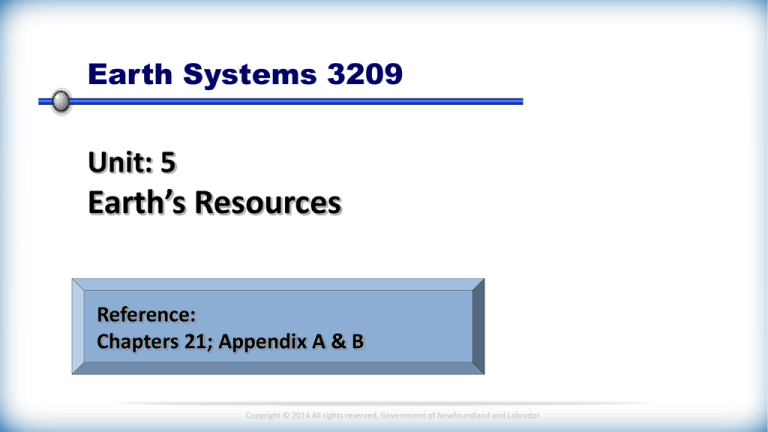
Earth Systems 3209
Unit: 5
Earth’s Resources
Reference:
Chapters 21; Appendix A & B
Copyright © 2014 All rights reserved, Government of Newfoundland and Labrador
Unit 5:
Topic 2.1
Types of Mines
Focus on . . .
identifying the different types of mining.
evaluating the advantages and disadvantages
associated with each type of mining.
Copyright © 2014 All rights reserved, Government of Newfoundland and Labrador
Types of Mines
1) Open Pit Mine
2) Underground
Copyright © 2014 All rights reserved, Government of Newfoundland and Labrador
Types of Mines
1) Open Pit Mining
Surface mining in which huge portions of Earth are dug from
the surface to extract the desired mineral within them,
resulting in a large pit.
Open pit mines are usually accessed by surface terracing,
thereby allowing technological equipment to follow the
shape of the deposit.
Open-pit mines are used when deposits of commercially
useful minerals or rocks are found near the surface.
As a result, the potential exists for considerable destruction
to both surface soil and vegetation, and the release of
significant amounts of mine dust.
Copyright © 2014 All rights reserved, Government of Newfoundland and Labrador
Types of Mines
1) Open Pit Mining
Copyright © 2014 All rights reserved, Government of Newfoundland and Labrador
Impacts of Open Pit Mines
1. Clearing: First the bulldozing and preparation kills all existing floral
and fauna species on the site.
2. Mining: Open-pit mining is known for its large amount of dust
production. Also the noise created.
3. Chemical and Toxic Pollution: The chemicals and toxins released
seep into nearby water supplies and pollute it.
4. Soil Degradation: Strong acidic or alkaline deposits begin to seep
into the surrounding soil making them useless in terms of growth.
5. Exposure: The exposure to weathering erodes the soil much quicker.
Some soils endure mass compaction.
6. Scree: Mining operations in mountain sides start to cut into the Earth
creating a scree drop effect.
Copyright © 2014 All rights reserved, Government of Newfoundland and Labrador
Pros/Cons of Open Pit Mines
Open-pit mining in relation to underground mining
experience lower costs, greater safety, and
mechanically easier operations.
Surface mining is more efficient than underground
mining in terms of recovery, grade control, economy,
and flexibility of operation.
However, many deposits, are too small or irregular,
and/or deeply buried to be extracted efficiently by
surface mining methods and the mine must be
converted to underground operations or abandoned.
Copyright © 2014 All rights reserved, Government of Newfoundland and Labrador
Types of Mines
2) Underground Mining
Underground mining is done when the rocks, minerals, or gemstones
are too far underground and can not be extracted economically by
surface mining or if the shape of the ore body is better suited for
underground mining.
Some underground
mining techniques
include:
Drift Mining,
Slope Mining,
Shaft Mining.
Copyright © 2014 All rights reserved, Government of Newfoundland and Labrador
Types of Mines
2) Underground Mining
Accessing underground ore can
be achieved via a decline (ramp),
inclined vertical shaft or adit.
Levels are excavated horizontally
off the decline or shaft to access
the ore body. Slopes are then
excavated perpendicular (or near
perpendicular) to the level into
the ore.
Copyright © 2014 All rights reserved, Government of Newfoundland and Labrador
Example 1:
Which type of mining process involves excavating large
areas of land resulting in high levels of environmental
damage?
(A) open pit
(B) room and pillar
(C) underground
(D) shaft mines
Copyright © 2014 All rights reserved, Government of Newfoundland and Labrador
Example 2:
Which is the true statement regarding underground
mining operations?
A) they are cheaper to operate because of low-cost
equipment
B) they cause less environmental surface damage
when compared to open pit mines
C) they cause more dust and noise at the surface than
open pit operations
D) the ore is more costly to process that ore from an
open pit mine
Copyright © 2014 All rights reserved, Government of Newfoundland and Labrador
Your Turn . . .
Take the time and complete the following questions . . .
(Solutions to follow)
Questions:
What are two disadvantages of open-pit mines?
Copyright © 2014 All rights reserved, Government of Newfoundland and Labrador
Solutions . . .
Answer:
May include any two of the following:
1.
2.
3.
4.
5.
6.
Clearing: First the bulldozing and preparation kills all existing floral and fauna
species on the site.
Mining: Open-pit mining is infamous for its large amount of dust production. Also
the noise created.
Chemical and Toxic Pollution: The chemicals and toxins released seep into
nearby water supplies and pollute it.
Soil Degradation: Strong acidic or alkaline deposits begin to seep into the
surrounding soil making them useless in terms of growth.
Exposure: The exposure to weathering erodes the soil much quicker. Some soils
endure mass compaction.
Scree: Mining operations in mountain sides start to cut into the Earth creating a
scree drop effect.
Copyright © 2014 All rights reserved, Government of Newfoundland and Labrador
Summary . . .
Overview of Points covered:
Two types of Mining:
1) Open Pit Mining
2) Underground Mining
Pros and Cons of the two types of mining:
Open-pit mining in relation to underground mining are lower costs,
greater safety, and mechanically easier operations.
Surface mining is more efficient than underground mining in terms of
recovery, grade control, economy, and flexibility of operation.
However, many deposits, are too small or irregular, and/or deeply
buried to be extracted efficiently by surface mining methods and the
mine must be converted to underground operations or abandoned.
Copyright © 2014 All rights reserved, Government of Newfoundland and Labrador







